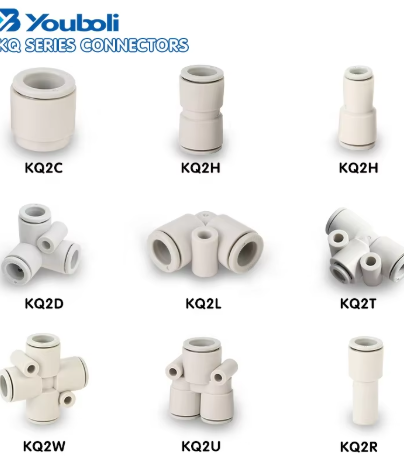Introduction
Picture this: a state-of-the-art automated packaging line suddenly grinds to a halt. After hours of troubleshooting, technicians discover the culprit—a single, poorly installed pneumatic connector that's leaking compressed air. This scenario plays out daily in factories worldwide, costing thousands in lost productivity. In fact, industry studies indicate that connection-related issues account for approximately 30% of pneumatic system failures.
If you work with pneumatic systems—whether as a design engineer, maintenance technician, or plant manager—understanding pneumatic connectors is anything but trivial. These seemingly simple components serve as the critical interface between your air supply and components, directly impacting system efficiency, safety, and operational costs. This comprehensive guide will transform your understanding of pneumatic connectors, revealing not just what they are, but how to select, install, and maintain them for optimal performance.
Why Pneumatic Connectors Matter: More Than Just Fittings
Pneumatic connectors might appear to be simple mechanical components, but their role in system performance is profoundly important. Often overlooked in system design, these components actually determine several critical performance factors.
The Hidden Impact on System Efficiency
Compressed air generation accounts for approximately 15-30% of industrial electricity consumption in manufacturing facilities. Leaky or restrictive connectors contribute significantly to this energy waste:
A single poorly-sealed connector leaking at 100 psi can waste approximately $1,000 annually in compressed air generation costs
Restrictive fittings can create pressure drops up to 5 psi, forcing compressors to work harder
Inconsistent connections lead to variable actuator speeds, affecting production quality
Safety Implications
Proper connectors prevent dangerous incidents:
Secure connections prevent hose whip accidents (which cause hundreds of injuries annually)
Correct materials prevent chemical compatibility issues
Proper locking mechanisms prevent unexpected disconnections during operation
Maintenance and Downtime Considerations
The right connectors significantly impact maintenance operations:
Quick-disconnect styles can reduce component replacement time by up to 70%
Standardized connections simplify troubleshooting and reduce inventory requirements
Quality connectors maintain seal integrity for years versus months with inferior products
What Exactly Are Pneumatic Connectors? Beyond the Basic Definition
At its simplest, a pneumatic connector is a device that joins sections of tubing, hose, or pipe to other pneumatic components. But this definition barely scratches the surface of their engineering sophistication.
Anatomical Breakdown of a Modern Pneumatic Connector
Primary Components:
Body Housing: Typically brass, stainless steel, or engineering plastics
Sealing Mechanism: O-rings, tapered seats, or metal-to-metal seals
Gripping Mechanism: Barbed inserts, collets, or ferrule systems
Locking Mechanism: Threaded collars, push-to-lock releases, or lever systems
Technical Specifications That Matter:
Pressure Rating: Typically 150-300 psi for standard industrial applications
Temperature Range: -20°F to 200°F (-29°C to 93°C) for most applications
Flow Characteristics: Measured by Cv factor (flow coefficient)
Compatibility Materials: Specific to tubing materials (Nylon, Polyurethane, etc.)
The Physics of Connection: What Happens Inside
Understanding the engineering principles helps explain performance differences:
Sealing Mechanics
Quality connectors use multiple sealing strategies:
Primary seal (typically elastomeric O-rings)
Secondary mechanical seal (metal-to-metal contact)
Redundant sealing paths for critical applications
Flow Dynamics
Connector design dramatically affects airflow:
Laminar flow maintenance: Smooth internal transitions minimize turbulence
Pressure drop minimization: Computational fluid dynamics optimizes internal geometry
Volume considerations: Internal volume affects system response times
Types of Pneumatic Connectors: A Comprehensive Classification
Understanding connector types ensures proper selection for specific applications.
By Connection Method
Push-to-Connect Fittings
Operation: Simply push tubing into fitting for instant connection
Best for: Frequent changes, maintenance applications, tight spaces
Limitations: Higher cost, potentially lower vibration resistance
Threaded Connectors (NPT, BSPP, BSPT)
Operation: Screw-together connection with sealant or sealing surfaces
Best for: High-pressure applications, permanent installations
Limitations: Installation time, potential for over-tightening
Barbed Fittings with Clamps
Operation: Push tubing over barbed end, secure with clamp
Best for: Low-pressure applications, cost-sensitive installations
Limitations: Higher leakage potential, not for dynamic applications
Quick-Disconnect Couplers
Operation: Push-and-click connection with automatic shut-off
Best for: Applications requiring frequent tool changes
Limitations: Higher pressure drop, potential for incomplete engagement
By Function and Application
Straight Connectors
Join two sections of tubing in a straight line
Elbow and Angle Connectors
90° or 45° angles for routing around obstacles
Tee and Cross Connectors
Divide flow to multiple directions
Reducer/Expander Connectors
Join different tubing sizes together
Swivel Connectors
Allow rotation while maintaining seal integrity
How to Select the Right Pneumatic Connector: A Step-by-Step Methodology
Follow this systematic approach to ensure optimal connector selection.
Step 1: Assess Application Requirements
Environmental Factors
Temperature extremes (consider thermal expansion differences)
Chemical exposure (lubricants, cleaning agents, environmental chemicals)
UV exposure (for outdoor applications)
Particulate contamination risk
Operational Parameters
Pressure ranges (including surge pressures)
Flow requirements (calculate based on actuator needs)
Cycle frequency (continuous vs. intermittent operation)
Vibration levels (equipment-mounted vs. stationary)
Maintenance Considerations
Expected frequency of disconnection
Technician skill level
Space constraints for tool access
Step 2: Calculate Technical Requirements
Flow Capacity Calculations
Use the Cv factor to determine flow compatibility:
Actual Flow (SCFM) = Cv × 22.48 × √(ΔP × (P + 14.7))
Where:
ΔP = Allowable pressure drop (psi)
P = Operating pressure (psig)
Pressure Drop Considerations
Size connectors to maintain pressure drop below 1-2 psi at maximum flow
Volume Considerations
For critical response-time applications, minimize internal volume:
Internal Volume = π × r² × h
Where r = internal radius, h = internal length
Step 3: Material Selection Guide
Brass
Pros: Excellent machinability, good corrosion resistance, cost-effective
Cons: Not suitable for highly corrosive environments
Best for: General industrial applications
Stainless Steel
Pros: Superior corrosion resistance, high strength
Cons: Higher cost, more difficult to machine
Best for: Food processing, chemical, marine environments
Plastic (Nylon, Polypropylene, PEEK)
Pros: Chemical resistance, lightweight, non-conductive
Cons: Temperature limitations, potential for UV degradation
Best for: Laboratory equipment, low-weight applications
Aluminum
Pros: Lightweight, moderate corrosion resistance
Cons: Lower strength than steel, galvanic corrosion concerns
Best for: Aerospace, mobile equipment
Step 4: Installation Best Practices
Preparation Procedures
Cut tubing square with dedicated tubing cutter—never use standard scissors
Deburr internal and external edges completely
Measure and mark insertion depth on tubing
Clean tubing ends with isopropyl alcohol
Installation Techniques
For push-to-connect: Push firmly until audible click or visible marker disappearance
For threaded fittings: Use proper sealant (Teflon tape or liquid thread sealant)
For barbed fittings: Use appropriate clamp tension—overtightening damages tubing
Verification and Testing
Pressure test at 150% of operating pressure
Soap solution bubble test for leaks
Pull-out test to verify retention strength
The Pros and Cons: Comparing Pneumatic Connector Technologies
Push-to-Connect vs. Threaded: A Detailed Comparison
Push-to-Connect Advantages
Installation speed (up to 5x faster than threaded connections)
No special tools required
Reusable multiple times
Visual connection verification
Push-to-Connect Disadvantages
Higher initial component cost
Bulkier design
Potential for lower vibration resistance in some designs
Temperature limitations based on O-ring materials
Threaded Connection Advantages
Lower component cost
Compact design
Excellent vibration resistance when properly installed
Higher temperature capability (metal-to-metal sealing)
Threaded Connection Disadvantages
Installation time and skill requirements
Potential for thread damage during installation
Difficult disassembly after long service
Sealant compatibility issues
Material Comparison Table
| Material | Pressure Rating | Temp Range | Chemical Resistance | Cost |
|---|---|---|---|---|
| Brass | High | Medium | Medium | Low |
| Stainless Steel | Very High | Very Wide | Excellent | High |
| Nylon | Medium | Narrow | Good | Very Low |
| Polypropylene | Low | Narrow | Excellent | Low |
| PEEK | High | Wide | Excellent | Very High |
Advanced Installation Techniques and Troubleshooting
Professional Installation Secrets
Threaded Connection Excellence
Use proper thread sealant: Teflon tape for NPT, liquid sealant for parallel threads
Engage threads by hand for first 3-4 turns to prevent cross-threading
Tighten to proper torque: Typically 1-2 turns past hand-tight for NPT
Avoid over-tightening—this deforms sealing surfaces and creates stress points
Push-to-Connect Perfection
Ensure tubing end is perfectly square and deburred
Lubricate tubing end with water or silicone spray (if recommended)
Push firmly until fully seated—listen for audible click where possible
Give a gentle pull test to verify retention
Troubleshooting Common Issues
Leakage Problems
Cause: Damaged O-rings or sealing surfaces
Solution: Replace connector or O-ring if serviceable
Prevention: Regular inspection, proper installation techniques
Tubing Pull-Out
Cause: Insufficient insertion depth or damaged gripping mechanism
Solution: Reinsert properly or replace connector
Prevention: Mark insertion depth on tubing, avoid excessive force
Restricted Flow
Cause: Undersized connector or internal obstruction
Solution: Replace with properly sized connector
Prevention: Proper sizing calculations, installation cleanliness
The Future of Pneumatic Connectivity: Emerging Trends
Smart Connectors
Integrated pressure sensors for real-time monitoring
Flow measurement capabilities
Wireless connectivity for predictive maintenance
Advanced Materials
Polymer composites with metal-like strength
Self-healing sealing technologies
Nanocoating for reduced friction and improved sealing
Sustainability Initiatives
Recyclable material designs
Reduced internal volumes for lower air consumption
Longer service life designs reducing waste
Conclusion: Making Informed Connector Choices
Pneumatic connectors represent both the simplest and most critical components in your pneumatic system. Their proper selection and installation directly impact:
Energy Efficiency: Quality connections reduce compressed air waste
System Reliability: Proper connectors prevent unexpected downtime
Maintenance Costs: Good design reduces service requirements
Safety: Secure connections prevent hazardous incidents
Remember that the lowest initial cost often results in higher lifetime expenses through energy waste, maintenance, and downtime. Invest in quality connectors appropriate for your specific application, and implement proper installation procedures.
Table of Contents
- Introduction
- Why Pneumatic Connectors Matter: More Than Just Fittings
- What Exactly Are Pneumatic Connectors? Beyond the Basic Definition
- Types of Pneumatic Connectors: A Comprehensive Classification
- How to Select the Right Pneumatic Connector: A Step-by-Step Methodology
- The Pros and Cons: Comparing Pneumatic Connector Technologies
- Advanced Installation Techniques and Troubleshooting
- The Future of Pneumatic Connectivity: Emerging Trends
- Conclusion: Making Informed Connector Choices

